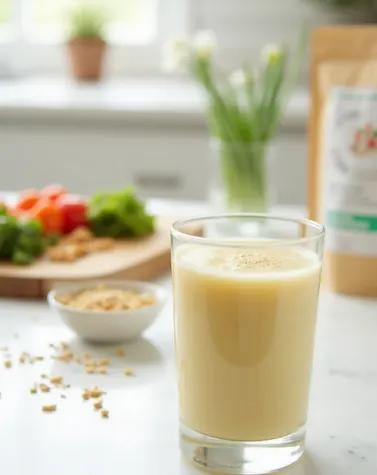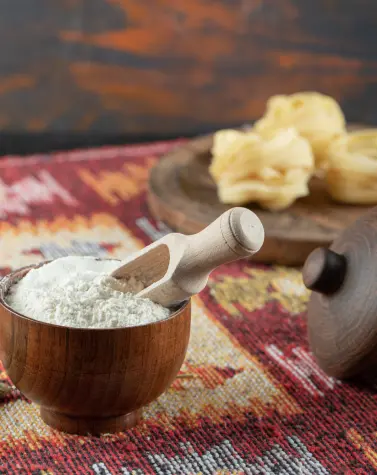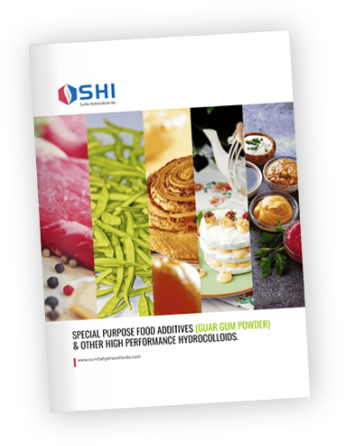
Gellan Gum vs Guar Gum: Benefits, Risks and Health Impacts Explained
Modern food production relies heavily on food additives like guar gum, gellan gum and xanthan gum to improve texture, stability and shelf life of food products. These gums are used in everything from almond milk and gluten free bread to ice cream and pudding.
These substances act as thickening and gelling agents and benefit significantly when it comes to attaining better product texture. In this post, you will learn about the two popular gums derived from natural sources – guar gum (from the guar bean) and gellan gum (produced via fermentation) and how they compare to each other and other gums.
Gellan Gum & Guar Gum as Food Additives
The food industry utilizes a wide variety of gums. Each has its unique characteristics.
- Guar Gum – extracted from the guar bean, is widely used for thickening and binding in gluten free products and dairy free foods.
- Gellan Gum – a bacterial fermentation product is used as a strong gelling agent in plant based dairy and desserts.
Each gum reacts differently to heat, acidity and other ingredients. This determines and justifies its specific use and applications.
Benefits of Gellan Gum
Gellan gum is highly water soluble polysaccharide produced via controlled bacterial fermentation. It is created by fermenting sugar with the bacteria Sphingomonas elodea and has some standout qualities:
- Strong gelling power at low concentrations
- Maintains structure in acidic and heat treated products
- Offers a smooth, creamy texture in plant based beverages
- Used in jellies, puddings, yogurts, non dairy milks and processed foods
- Lowers cholesterol and supports digestion as per a research
Due to its ability to replace animal based gelatins, gellan gum is popular in vegan and allergy friendly foods.
Benefits of Guar Gum
Guar gum is a natural water soluble polysaccharide produced from the seeds of the guar plant. It has several unique advantages:
- Excellent thickening & stabilizing properties at low concentrations
- Enhances viscosity in food products
- Improves texture and mouthfeel
- Helps prevent ice crystal formation in frozen desserts
- Commonly used in sauces, soups, baked goods, dairy products and processed foods
- Aids digestion and supports blood sugar regulation, as per research
Guar gum is popular in gluten free and plant based formulations due to its ability to improve elasticity and moisture retention. Its versatility makes guar gum a staple ingredient in food, cosmetics and pharmaceuticals.
Gellan gum and Guar Gum – A Comparison
Both gums are versatile and have unique applications depending on the desired texture and stability.
| Parameter | Gellan Gum | Guar Gum |
| Source | Fermented bacterial polysaccharide | Derived from guar plant seeds |
| Texture & Function | Strong gelling agent, forms firm gels | Excellent thickener and stabilizer |
| Solubility | Water soluble (especially cold water), works well in acidic conditions | Water soluble (especially warm), enhances viscosity |
| Common Applications | Jellies, puddings, plant based beverages | Sauces, soups, baked goods, dairy products |
| Heat Stability | Maintains structure under heat and acidic conditions | Stable but less resistant to heat than gellan gum |
| Dietary Benefits | Potential digestive support and cholesterol lowering | May aid digestion and support blood sugar regulation |
| Vegan & Allergy Use | Widely used as a gelatin substitute in vegan foods | Popular in gluten free and plant based product |
Gellan Gum vs Guar Gum in Baked Goods
Gums like guar and gellan enhance structure and texture in baked goods.
- Guar gum – helps retain moisture, reduce crumbling and improve rise – essential in gluten free baking.
- Gellan gum – though used less frequently in baking, offers benefits in specific gluten free and egg free recipes.
These ingredients help create softer cakes, chewier cookies and bread with better structure – all without gluten or eggs. Other gums like locust bean gum (carob gum) add fiber and aid in even mixing.
Gellan Gum vs Guar Gum Dairy Products
In both, dairy and non dairy products, gums improve mouthfeel and prevent separation.
- Guar gum – thickens yogurt, cream cheese and ice cream and offers a rich, creamy consistency.
- Gellan gum – stabilizes plant based milks (almond milk and oat milk) and gives body to non dairy creamers.
These gums keep processed foods smooth, emulsified and looking good on store shelves. Carrageenan, locust bean gum and gum arabic are also commonly used in cheese, milk drinks and spreads.
Impact of Gellan Gum & Guar Gum on Digestive Health
Gums can support or challenge digestion depending on dosage and individual tolerance.
- Guar gum – acts as a prebiotic fiber due to its stool bulking properties. It promotes gut health and regulates blood sugar.
- Gellan gum – may offer similar health benefits but it needs more human research.
As with all food additives, moderation is key. Overconsumption of any gum can cause gas, bloating or loose stools, especially in sensitive individuals. Effects vary based on digestive health, microbiome and how much is consumed at once.
Food Additive Regulations
Food gums are subject to strict oversight. In the U.S., the FDA classifies guar gum, gellan gum, and others as GRAS (Generally Recognized as Safe). Manufacturers are to follow rules for maximum usage levels, purity and labeling. Additives are to be clearly listed on product labels (e.g., “gellan gum” or “E418”) as consumers have the right to know what’s in their food and regulations ensure they do.
How to Choose Between Gellan Gum & Guar Gum?
Choosing between gellan gum and guar gum depends on the specific needs of your product or recipe. For firm gels and structured textures, gellan gum is ideal. For thickening and viscosity improvement, guar gum works better. Consider heat and acid stability as well.





